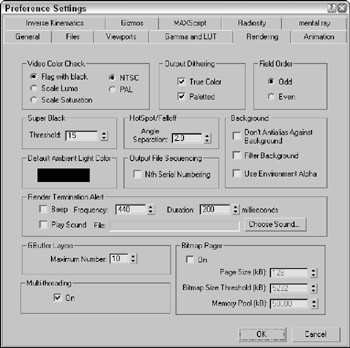Rendering Preferences
In addition to the settings available in the Render Scene dialog box, the Rendering panel in the Preference Settings dialog box includes many global rendering settings. The Preference Settings dialog box can be opened using the Customize ![]() Preferences menu command. Figure 43.8 shows this panel.
Preferences menu command. Figure 43.8 shows this panel.

Figure 43-8: The Rendering panel in the Preference Settings dialog box lets you set global rendering settings.
The Video Color Check options specify how unsafe video colors are flagged or corrected. The Flag with black option shows the unsafe colors, and the Scale Luma and Scale Saturation options correct them by scaling either the luminance or the saturation until they are in range. You can also choose to check NTSC or PAL formats.
| Caution | Be aware that the Scale options can discolor some objects. |
Output Dithering options can enable or disable dithering of colors. The options include True Color for 24-bit images and Paletted for 8-bit images.
The Field Order options let you select which field is rendered first. Some video devices use even first, and others use odd first. Check your specific device to see which setting is correct.
The Super Black Threshold setting is the level below which black is displayed as Super Black.
The Angle Separation value sets the angle between the Hotspot and Falloff cones of a light. If the Hotspot angle equals the Falloff angle, then alias artifacts will appear.
The Don't Anti-alias Against Background option should be enabled if you plan on using a rendered object as part of a composite image. The Filter Background option includes the background image in the anti-aliasing calculations. The Use Environment Alpha option combines the background image's alpha channel with the scene object's alpha channel.
The Default Ambient Light Color is the darkest color for rendered shadows in the scene. Selecting a color other than black brightens the shadows.
You can set the Output File Sequencing option to list the frames in order if the Nth Serial Numbering option is enabled. If the Nth Serial Numbering option is disabled, the sequence uses the actual frame numbers.
In the Render Termination Alert section, you can elect to have a beep triggered when a rendering job is finished. The Frequency value changes the pitch of the sound, and the Duration value changes its length. You can also choose to load and play a different sound. The Choose Sound button opens a File dialog box where you can select the sound file to play.
The GBuffer Layers value is the maximum number of graphics buffers to allow during rendering. This value can range between 1 and 1000. The value you can use depends on the memory of your system.
The Multi-threading option enables the renderer to complete different rendering tasks as separate threads. Threads use the available processor cycles more efficiently by subdividing tasks. This option should be enabled, especially if you're rendering on a multiprocessor computer.
The Bitmap Pager option breaks rendered images into pages with a specified size. This keeps images from becoming so large that they become difficult to work with. Once enabled, you can specify the Page Size, the Bitmap Size Threshold, and the size in KB of the Memory Pool.